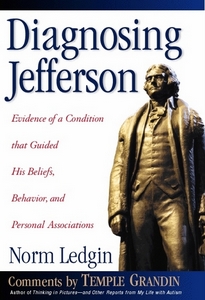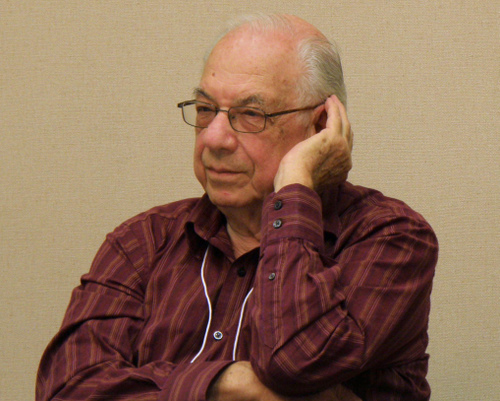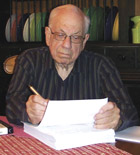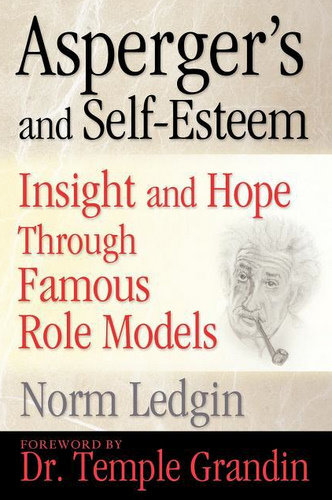- Was Einstein On The Autism Spectrum?
- Learn From The Historian Who Diagnosed Jefferson, Mozart and Einstein With Autism
- Find Out About Thomas Jefferson’s Relationship With A Slave
Full Interview Audio

Personal Info
Sports Teams:NY Yankees
Favourite Books:
- The Grapes of Wrath by John Steinbeck
- Thinking In Pictures: and Other Reports from My Life with Autism by Temple Grandin
- The Complete Guide to Asperger’s Syndrome by Tony Attwood
Most Influenced By:Richard McCormick, Edward McNall Burns
Company Website: http://NormLedgin.com
Relevant Link: http://www.youtube.com/watch?v=wRRNeAilrnM
Interview Highlights
This is a condensed, lightly edited transcript of an audio interview. The full audio is available and highly recommended. The interviewee may post clarifications in the comments.
Adrian Bye: Today I’m here with Norm Ledgin. Norm, can you tell us about your connections with the autism community?
Norm Ledgin: I have come to this late in life because it wasn’t until 1996 that my son was diagnosed with Asperger’s Syndrome. Immediately, I took an interest in the condition to the extent that I read everything then available. I think Uta Frith was the major work at that time. Tony Attwood was just bringing out his book on Asperger’s Syndrome. I went to listen to Temple Grandin. I read her book, Thinking in Pictures. At that time, there wasn’t a whole lot available.
I started to develop my book, Diagnosing Jefferson, beginning around 1998.
Adrian Bye: What made you decide to write that book?
Norm Ledgin: What made me decide was matching idiosyncrasies that I saw in my son with those that I was reading about in the Jefferson biographies. I was in the midst of reading the six volume biography by Dumas Malone. I was surprised that, although he mentioned the idiosyncrasies, he didn’t really look into any pattern or any relationship.
When I found 20 matches between my son’s behavior and Jefferson’s behavior, I became extremely interested in doing something about it. When I found 50 matches, I decided right then and there that I was going to write a book.
It was a two year project. I asked Temple Grandin to write comments for the book., but she wouldn’t do it until she saw a lot more detail. Because she’s so fact-oriented, she wanted to be satisfied that there was enough detail to attract her. She went through three drafts of mine before she agreed to become a part of it. I’m glad she was so insistent because it turned out to be a better book than it might otherwise have been.
Adrian Bye: What were the things that started jumping out as you were learning about Jefferson?
Norm Ledgin: There was a reticence on my son’s part to engage physically, even though we tried on a number of occasions to give him hugs and to be close physically.
He also perseverated a great deal on topics that were of absolutely no interest to us, such as the details from various motels that he picked up from reading guide books. He seemed interested in memorizing the amenities available in one chain after another. Also, automobiles. I had to pick up various descriptions of cars from car dealers in order to satisfy his voracious appetite for detail.
These sorts of things jumped out at me as very much like Jefferson’s interests in rather obscure topics.
Adrian Bye: How do you get from memorizing details about motels to writing the Declaration of Independence?
Norm Ledgin: People who read the Declaration of Independence don’t see the same thing that I see in it. It’s a bill of indictment against George III, and the details of that indictment are enumerated very specifically. In that respect, I would say it falls into the fact-based syndrome that Jefferson exhibited.
Adrian Bye: In the book, you talk about a relationship with one of his slaves.
Norm Ledgin: Yes, with Sally Hemings. I refer to that as a very logical choice on his part, because she was the half-sister of his late wife. She was family, in addition to being technically his slave. She was also 3/4 white. When they connected in Paris, she made that choice freely because in France there was no recognition of slavery. She was a free person. She was 15 years old when they connected, but she was able to determine on her own that this was a relationship worth entering.
Partly because she had the example of her mother, Elizabeth Hemings. At the time his wife died, she exacted a promise from him on her death-bed that he would never remarry. In the room was 9 year old Sally. The unreasonable expectation would be that he would become celibate for the rest of his life. That wasn’t going to happen. Sally knew this, and Sally’s mother knew this. I believe that there was a lot of conversation about the possibilities for one of the daughters, Sally, to imitate what Elizabeth Hemings had accomplished with John Wayles, father-in-law to Thomas Jefferson. As a result, Elizabeth encouraged Sally to go to France five years later when they needed an escort for Mary, Jefferson’s second daughter.
The connection was based on her ambition, to some extent, and his need. The testimony to the success of that relationship was that it lasted 38 years, until he died. They had 8 children together, 4 of whom survived.
Adrian Bye: Was he taking a social risk by this relationship?
Norm Ledgin: Yes. In 1802, in September, in the Richmond Register, a series of articles was started by a man named James Callender. He began to expose the relationship. Of course, everyone expected Jefferson to deny it. Instead of denying it, he just didn’t talk about it at all.
In 1802, he was already president, and he had already decided that he wanted a second term. He was exposed, but he didn’t let it bother him, and even more significant, he continued the relationship until he died in 1826.
Adrian Bye: Is there any ambiguity as to the relationship actually existing? Do we have DNA evidence?
Norm Ledgin: I’ve met descendants of the couple. There’s no doubt in the mind of anybody who is looking at this objectively that this really happened. We have the DNA evidence to back up some of it. We also have the logic of the situation. At the time they connected, the opportunity was very much in front of both of them in Paris. The need was clear. The ambition by Sally that we can deduce from her experience in the Hemings family was present.
Adrian Bye: When they were together, did he have relationships with other women as well?
Norm Ledgin: According to his account books, which tell his whereabouts, and everything he spent money for, there’s no way we could regard either of them as having been disloyal. I think it was a romance that was very deep and profound.
Adrian Bye: What happened with her and her kids after he died?
Norm Ledgin: Her children had been freed by a promise that he had made back in Paris. Even though she was only pregnant with her first, they agreed that if she returned to the United States, where she would be a slave again, that he would free all children that they would have together. 
Adrian Bye: Simon Baron-Cohen has looked at Einstein and Newton and whether they were on the autism spectrum. Have you looked into many other people?
Norm Ledgin: I had a book published called Asperger’s and Self Esteem, a couple of years after I wrote about Jefferson, and Einstein and Mozart were in there.
In the biography of Einstein by Walter Isaacson, he has a footnote that is critical of both Simon Baron-Cohen and myself for pegging Einstein with Asperger’s Syndrome. Isaacson said that it couldn’t be true because Einstein had a lot of friends. The fact of the matter is those friendships were pretty much one-sided. People with Asperger’s have a tendency to attract the attention of others. While there is a friendship established by such an attraction, it’s not always reciprocal.
The American Psychiatric Association, after I pointed that out in my Jefferson book, came out with a revision in 2000, saying that a lot of friendships may develop in mid-life, but they are usually one-sided.
I also put in people like Orson Welles and Bela Bartok, the Hungarian composer, and Oscar Levant, the pianist who popularized Gershwin’s music. Glenn Gould, the pianist whose biographer also happened to be his psychiatrist. Marie Curie, Paul Robeson, Carl Sagan and Charles Darwin.
Adrian Bye: People who look at this today would say: “this is crazy, the only way to make a real diagnosis is through parental interviews and interviewing the person”.
Norm Ledgin: They’re right. It’s not the diagnosis. It’s a supposition that they belong on the autism/Asperger’s continuum because their behavior fits the criteria that have been outlined by the American Psychiatric Association. There is no way to diagnose a dead person. There is only a conclusion you can come to based on what you know, especially on what you know of the earliest of their lives when they are exhibiting classic symptoms and haven’t yet begun to adjust things like eye gaze, etc.
Adrian Bye: Of the well known people from the past that you’ve looked into, who would be the ones you’re most certain of?
Norm Ledgin: Glenn Gould, the pianist. Paul Robeson, the singer. Oscar Levant, the pianist. Thomas Jefferson, the violinist. He was one of the top five violinist of his day before he broke his wrist. Mozart and Einstein.
Adrian Bye: Taking Einstein, for example, how would you have picked up on him?
Norm Ledgin: He was fixated. Classic fixations. Never did accomplish all that he wanted to in scientific research. He was very captivated by his own perseverating on various scientific subjects when he was a young man. He didn’t get along with his teachers because he was telling them how to do their jobs. He just didn’t go along with the formula of the relationship between student and teacher that was prevalent at the time. He was just different in every respect from his contemporaries.
He is a far more interesting personality than history has given him credit for being. We think of him as a super-intellectual who is so profound in his theories that the world couldn’t run any longer if we didn’t see it obeying the forces that he described. But, as a person, he had the classic quirks that you would associate with Asperger’s Syndrome in his relationships with other people.
I also have the same feelings about Mozart, who was bullied by his father and seems to have succeeded at two levels despite it. He was a child prodigy as a pianist, but later as a composer, and did less performing in later life. He had quirks out the wazoo, as we say.
Of the hundreds of the quirks that we can identify among various people with Asperger’s Syndrome, no two people are alike. One will have a set of 30 or 40 that we can identify, another one will have 80 that we can identify, and maybe only on 10 of those idiosyncrasies will they coincide. No two Asperger’s people are alike in that respect, which makes the entire syndrome an interesting study. But, if we go on the American Psychiatric Association, we can identify the condition. Notice I call it a condition and not a disability, because I look at it from the standpoint of Asperger’s having in fact enhanced some of the talents that were latent in these people.









